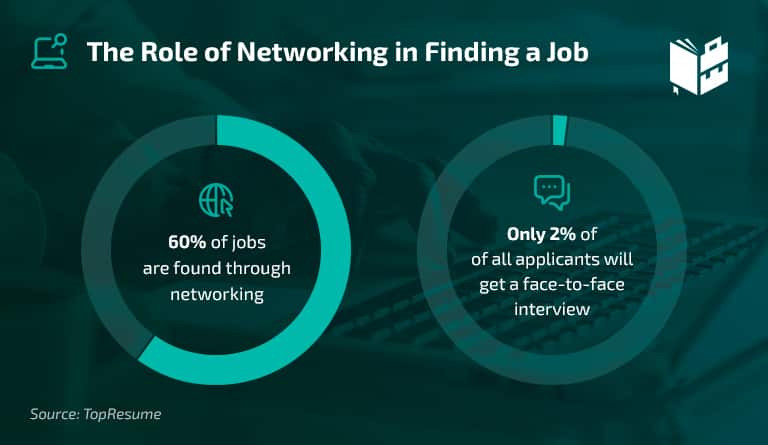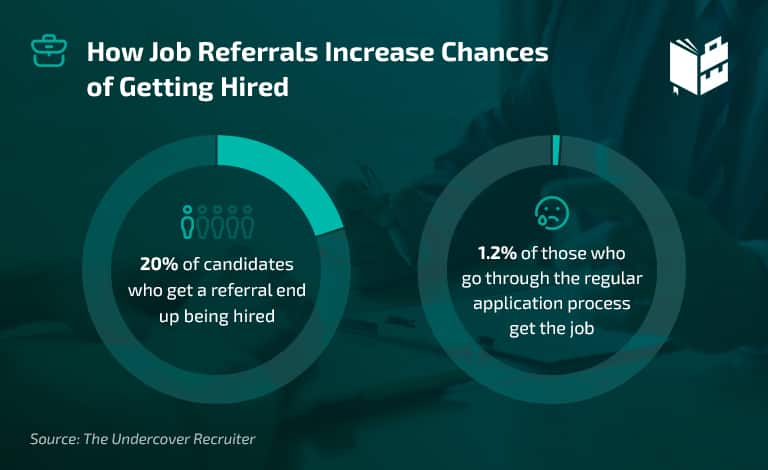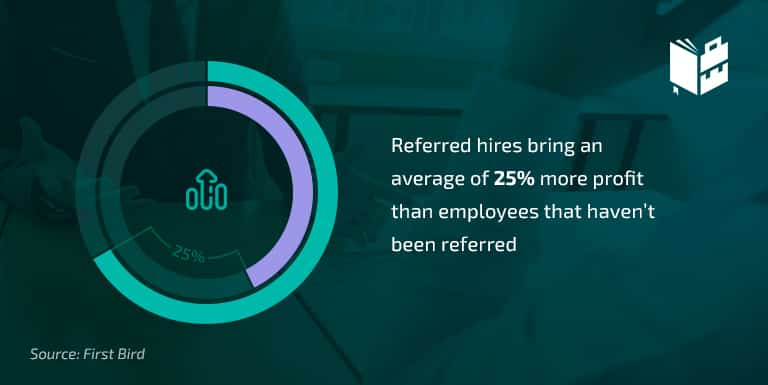Employee referral programs are the best way for businesses to find reliable and skilled employees. According to employee referral statistics, this is the process of asking current workers to recommend someone they know for any open positions available at the workplace.
Employee referral can improve the quality of applicants for a job position while also decreasing the amount of time that it takes to find a qualified person. While it may seem odd to recruit potential employees who may already be employed, most people are open to considering new job opportunities.
Here are our 18 most interesting stats on employee referral to help you decide if it’s right for your company.
Best Employee Referral Program Statistics (Editor’s Choice)
- Almost 90% of individuals are susceptible to considering new job opportunities.
- The most popular way for individuals to find new jobs is through referrals.
- Employee referral programs decrease the time it takes to hire.
- By hiring through referral programs, the cost an employer has to pay per hire decreases.
- Hiring through referrals gives you the highest return on investment rate.
- Using referral programs for hiring increases your employee retention rate.
- Employees hired through referrals generate more profit for your company.
- Referred applicants are more likely to accept your job offer than regular applicants.
Employment Statistics
Whether you’re an individual who’s actively searching for a job or a company owner gearing up to hire new staff, the hiring process comes with many variables. In today’s digital world, more people than ever are applying for jobs online, leaving the traditional face-to-face approach behind. These statistics show that leaving classic techniques behind might not be the most effective.
1. 60% of jobs are found through networking.
(TopResume)
It may be easier to browse through jobs on your favorite job site and send out your resume en masse, but statistics show that the percentage of jobs found through networking far outweighs those found applying online.
Even in a world of equal opportunity, who you know and how you present yourself is still the main way people find new employment opportunities. Since only 2% of applications will even get a face-to-face interview, promoting yourself in your network is still the best way to get hired.

2. Roughly 70% of the worldwide labor pool consists of skilled individuals who aren’t actively looking for a job.
(LinkedIn)
While online platforms may appear to serve job seekers, hiring stats show that they also are useful interfaces for recruiters to find skilled candidates. Hiring statistics indicate just 30% of workers are actively seeking work, making referral programs a more efficient way to access experienced and skilled workers who are already employed.
3. Almost 90% of individuals are susceptible to considering new job opportunities.
(LinkedIn)
It might not be great for an employer to realize that most people are susceptible to changing their current jobs if they are given a better offer, but it seems that by using employee referrals, the facts suggest that you are likely to find a highly skilled worker who is willing to relocate to your business.
4. New career opportunities are the most common reasons why employees leave their jobs.
(LinkedIn)
There are several popular reasons why an individual would make the decision to change his career or his ongoing job based on workplace statistics. According to employee referral program analysis, the number one reason people leave their jobs is that they received a better career opportunity. Recruiting already employed individuals is a whole different technique than responding to job-seekers. Keeping competitive in the market as an employer is a must but returns great results.
5. The labor market is 90% applicant-driven.
(MRINetwork)
An applicant-driven market means that applicants are in a position to pick and choose between job offers. Employers are recruiting just 10% of the time in the global market, and human resources statistics show that excellent candidates almost always have multiple offers, putting employers in competition.
Referral programs can then be a useful tool for employers, as it allows them to be more active in their hiring process.
6. The most popular way for individuals to come upon new jobs is through referrals.
(LinkedIn)
A referral consists of individuals recommending one or two qualified and skilled candidates to occupy an open position within a company. Referrals are crucial when it comes to hiring, producing higher-quality hires overall.
7. On average, one out of five referred candidates is hired.
(The Undercover Recruiter)
Employee referral stats show that being referred for a job opening increases your chances of getting hired. In fact, according to recent data, referred applicants have a 20% chance of getting the job they competed for, compared to just 1.2% for those going through the regular application process.

8. Many businesses prioritize hiring referred individuals.
(First Bird)
There are multiple benefits to hiring referred candidates rather than through other methods. The importance of employee referral in business has been well supported. Referred candidates are more skilled, generate more profit, are cheaper to hire, and start earlier than those found online. As a result, company owners are 3-4 times more likely to employ referred individuals.
9. Roughly 2/3 of referred staff members suggested hiring a minimum of one candidate to their current employer.
(Forbes)
Referred hires are directly aware of the benefits of referral programs and are more likely to help the company with further referrals. Despite goodwill, incentive programs for referring such as bonuses or extra vacation days make employees very likely to participate.
Employee Referral Statistics
The benefits of referral programs are undeniable. While some companies may be wary of investing in the cost and time of making a good referral program, the profitability and success rate gives back in multiple ways. These stats delve deeper into the perks of getting employee referrals.
10. Employee referral programs decrease the time it takes to hire while also improving the quality of hire.
(Clutch)
In comparison to hiring through job searching websites, employing through referrals is 55% faster. Surveys regarding the benefits of employee referral programs show that 88% of employers utilizing or implementing referral programs reported that recruited candidates were of better quality than other candidates.
11. By hiring through referral programs, the cost an employer has to pay per hire decreases.
(The HR Tech Weekly)
By taking advantage of such beneficial hiring practices, business owners will spare roughly around $3,000 per individual they employ according to the average cost per hire statistics. Taking into consideration the fact that many businesses have 100+ employees, That sum eventually adds up to hundreds of thousands of dollars.
12. Employing through referrals gives you the highest return on investment rate.
(The HR Tech Weekly)
It is known that referral is generally a word-of-mouth marketing plan and that employing people who were referred decreases the average hire costs. As such, an employee referral program survey shows that 82% of employers consider referral programs the top way of getting a high ROI rate. The return on investment rate is high at such companies because referred employees tend to be overall better hires.
13. Employees hired through referrals generate more profit for your company.
(First Bird)
When it comes to generating profit for your company, the last accessible data on employee referral statistics specifies that taking a chance on referred individuals directly influences profitability. Referred hires bring an average of 25% more profit than employees that haven’t been referred.

14. Using referral programs for hiring increases your employee retention rate.
(Talent Lyft)
If you want your company to be successful, having a high retention rate is essential. Loyal employees are crucial to keep a business growing. According to the latest data about employee referral benefits, employees who were hired after being referred are more likely to stay at the company for a longer period of time than those individuals who were hired through job searching websites or other channels.
15. Referred applicants are more likely to accept your job offer than regular applicants.
(Glassdoor)
Referral recruitment hosts a different dynamic than the regular applicant-driven job search. Referred candidates are immediately in a different position when accepting an interview. Statistics on employee referral programs suggest that referred candidates are 2.6% to 6.6% more likely to accept a job offer than other applicants.
Their network connection to the company allows them to feel more confident about the business from the start, making them more likely to accept the job if offered.
16. Most employees refer to a candidate with the intention of helping out a friend or the business they work for.
(Workable)
There are three main reasons why people choose to refer someone to their company. Based on employee referral program statistics, the majority of referees report that it was to be helpful to either the candidate or to the business. Other reasons are for incentives advertised within the program or even to appear more valuable to the company.
17. Monetary referral bonuses range from $1,000 up to $5,000.
(BuiltIn)
While it can be for multiple reasons, incentives are a great way to encourage employees to think about participating in referral programs. Besides the incentive to help out connections or the business they work for, monetary bonuses are highly motivational. Employee referral bonus amounts range from $1,000 and can go up to as high as $5,000 based on various criteria such as the type of job that’s available, how difficult the particular position is, and also the duration of the vacant position.
While this may seem like a steep investment, it’s important to keep in mind that the average cost of a regular hire from a job posting costs between $5,000-$10,000.
Conclusion
Employee referral programs are frequently used and highly recommended, if for only one reason because they work. Employee referrals and the advantages that come with them, such as employee retention, profitability, cost of hire, and qualifications, are one of the best ways to find reliable and skilled workers.
Through providing incentives such as bonuses, or extra time-off, implementing one of these programs requires more effort in the initial stages but ultimately results in a more reliable, satisfied, and seamless work environment for both employees and business owners alike.